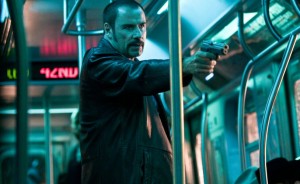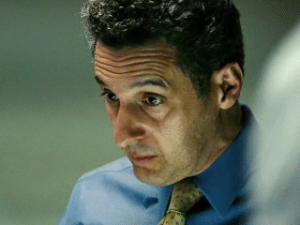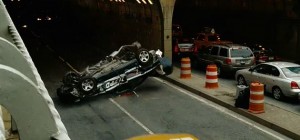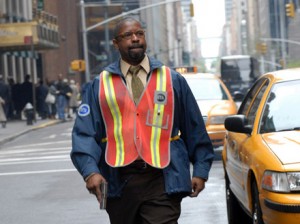The Taking of Pelham 123 (2009)
 Over the past few years, director Tony Scott (Top Gun, True Romance, Enemy of the State) has been taking shots from the press over his recent fascination with film school tricks like flash frames, jump cuts, color filtering and his insistence on somehow cutting his films even faster than he used to. Whether this is a compensation for aging by keeping up with the Michael Bays of the world is unknown. But the notion that he needed to make his already quickly cut films even faster has not helped anything other than the overtime hours the crew earns as Scott shoots all that extra footage.
Over the past few years, director Tony Scott (Top Gun, True Romance, Enemy of the State) has been taking shots from the press over his recent fascination with film school tricks like flash frames, jump cuts, color filtering and his insistence on somehow cutting his films even faster than he used to. Whether this is a compensation for aging by keeping up with the Michael Bays of the world is unknown. But the notion that he needed to make his already quickly cut films even faster has not helped anything other than the overtime hours the crew earns as Scott shoots all that extra footage.
Scott’s new practice of visually assaulting the viewer began with his remake of Man on Fire. And that should be plenty of evidence that despite the speed with which the shots go by, suggesting the movie would move that much faster, he turned what was originally a 90 minute film (made in 1987) into 2 ½ hours. The other thing that happened with Man on Fire is that Scott spent literally an hour of screen time just messing around with his just discovered techniques; and so the movie was not only distracted, but a bloated bore instead what should have been a junky exploitation movie. The success of Scott’s Man on Fire must have been validation and so he continued to ramp up the overload to a ridiculous extreme with Domino, which played like Scott’s version of Natural Born Killers, but even less subtle in its media satire.
 Chastened by Domino’s critical and financial failure, he went back to a safe place, under the aegis of his former producer Jerry Bruckheimer — with whom he had made Top Gun, Days of Thunder, Enemy of the State, Crimson Tide, and Beverly Hills Cop II — and made a comparatively safe film. That film, the gimmicky PG-13 Déjà vu, made in a relatively restrained fashion, gave the audience the ability to actually focus on the story instead of the technique. Unsurprisingly, it was also one of Scott’s best movies in years. Apart from its cop-out ending, it was nearly perfect in its structure and amusing stupidity, and a pared down version of Enemy of the State, complete with a group of tech nerds played by overqualified character actors (Val Kilmer and Adam Goldberg in Déjà Vu, Seth Green, Jack Black, and many others in Enemy) who were picking up a paycheck.
Chastened by Domino’s critical and financial failure, he went back to a safe place, under the aegis of his former producer Jerry Bruckheimer — with whom he had made Top Gun, Days of Thunder, Enemy of the State, Crimson Tide, and Beverly Hills Cop II — and made a comparatively safe film. That film, the gimmicky PG-13 Déjà vu, made in a relatively restrained fashion, gave the audience the ability to actually focus on the story instead of the technique. Unsurprisingly, it was also one of Scott’s best movies in years. Apart from its cop-out ending, it was nearly perfect in its structure and amusing stupidity, and a pared down version of Enemy of the State, complete with a group of tech nerds played by overqualified character actors (Val Kilmer and Adam Goldberg in Déjà Vu, Seth Green, Jack Black, and many others in Enemy) who were picking up a paycheck.
Since Déjà Vu, Scott has re-edited his relatively languid noir thriller Revenge and updated it for his perception of today’s audience by removing 35 minutes of story and character development and adding in 10 minutes of sex and violence.
His new film, a second remake of The Taking of Pelham 123, isn’t a headache to watch. But it does so little with its premise — a train heist with a hostage situation on the New York City subway line — that the most honest reaction a viewer might have is indifference.
 It isn’t so much that this Pelham remake is unnecessary (Though it is. But at least Scott hasn’t managed to put together his forever planned remake of The Warriors, a movie of its time if there ever was one), but that it’s kind of an old, fat version of an action thriller. Imagining Steven Seagal in the scenario, or even turning it into Under Siege 2 ½, wouldn’t be difficult. Even Pelham writer Brian Helgeland has done this sort of material better with his script for Conspiracy Theory. In the case of Conspiracy Theory, it started as a funny, tense, weird first half, which was like a big budget Taxi Driver that starred Mel Gibson. But it turned into a tired Lethal Weapon sequel halfway through; obviously the casualty of rewrites and second guessing by producer Joel Silver and director Richard Donner (who made all of the Lethal Weapon films together). Pelham 123 plays like Helgeland had the Lethal Weapon tone in mind all along, as evidenced by the extraneous car crashes that happen with the police cars every ten minutes or so. Helgeland didn’t even retain the original Pelham’s hilarious sneeze ending, opting for a standard chase and gun showdown instead.
It isn’t so much that this Pelham remake is unnecessary (Though it is. But at least Scott hasn’t managed to put together his forever planned remake of The Warriors, a movie of its time if there ever was one), but that it’s kind of an old, fat version of an action thriller. Imagining Steven Seagal in the scenario, or even turning it into Under Siege 2 ½, wouldn’t be difficult. Even Pelham writer Brian Helgeland has done this sort of material better with his script for Conspiracy Theory. In the case of Conspiracy Theory, it started as a funny, tense, weird first half, which was like a big budget Taxi Driver that starred Mel Gibson. But it turned into a tired Lethal Weapon sequel halfway through; obviously the casualty of rewrites and second guessing by producer Joel Silver and director Richard Donner (who made all of the Lethal Weapon films together). Pelham 123 plays like Helgeland had the Lethal Weapon tone in mind all along, as evidenced by the extraneous car crashes that happen with the police cars every ten minutes or so. Helgeland didn’t even retain the original Pelham’s hilarious sneeze ending, opting for a standard chase and gun showdown instead.
 The action beats are shoved down our throats in this Pelham, even though they don’t serve any purpose, except as noise and distraction, because they don’t add any actual suspense. And despite Tony Scott’s reliance on Sturm und Drang, it has the opposite of the intended effect; the movie is slow and glacially paced. None of the life that was in the characters from the original is retained. Denzel Washington (in Inside Man mode) is the pudgy train dispatcher dealing with a frothing-at-the-mouth villain, John Travolta. (He and his henchman have been renamed from the source material because Quentin Tarantino used the “criminals-with-colors-as-names” idea [Brown, Blue, etc.] in Reservoir Dogs). But neither Travolta nor Washington have the frumpy charm of Walter Matthau or Robert Shaw in the 1974 version. Yes, this is a new movie, and doesn’t have to follow the same rules. But Tony Scott doesn’t seem to understand that the story of Pelham isn’t one of an action movie — it’s actually the very opposite, an in-action movie. There’s a lot of waiting around, deadlines, threats, sweating. But Scott is only interested in pausing for exposition.
The action beats are shoved down our throats in this Pelham, even though they don’t serve any purpose, except as noise and distraction, because they don’t add any actual suspense. And despite Tony Scott’s reliance on Sturm und Drang, it has the opposite of the intended effect; the movie is slow and glacially paced. None of the life that was in the characters from the original is retained. Denzel Washington (in Inside Man mode) is the pudgy train dispatcher dealing with a frothing-at-the-mouth villain, John Travolta. (He and his henchman have been renamed from the source material because Quentin Tarantino used the “criminals-with-colors-as-names” idea [Brown, Blue, etc.] in Reservoir Dogs). But neither Travolta nor Washington have the frumpy charm of Walter Matthau or Robert Shaw in the 1974 version. Yes, this is a new movie, and doesn’t have to follow the same rules. But Tony Scott doesn’t seem to understand that the story of Pelham isn’t one of an action movie — it’s actually the very opposite, an in-action movie. There’s a lot of waiting around, deadlines, threats, sweating. But Scott is only interested in pausing for exposition.
 Instead of unnerving calm, Travolta rants and raves into the radio, ordering Washington and to get the mayor to pay up for the hostages (the mayor is played by James Gandolfini as an effeminate mix of former NYC mayor Rudy Guiliani and current NYC mayor Michael Bloomberg, tying in the personal lives and wealth of both). The only interesting element, besides the bogus notion and plot point where a guy videochats on his laptop with his girlfriend while underground on the train (this does not happen on NYC subways), is that Travolta, perhaps to add excitement or panache to his limp dialogue, throws in profanity at the end of every line as an afterthought. It is always awkward and never adds to the tension, even when Travolta requests a character to “lick my bunghole.” I don’t know whose idea the choices of language were, but emphasizing lines by adding “motherfucker” after every line doesn’t add realism or anything else. It just made me imagine Travolta’s character at home, calling out for his butler and saying, “Can you bring me some tea…. Motherfucker!”
Instead of unnerving calm, Travolta rants and raves into the radio, ordering Washington and to get the mayor to pay up for the hostages (the mayor is played by James Gandolfini as an effeminate mix of former NYC mayor Rudy Guiliani and current NYC mayor Michael Bloomberg, tying in the personal lives and wealth of both). The only interesting element, besides the bogus notion and plot point where a guy videochats on his laptop with his girlfriend while underground on the train (this does not happen on NYC subways), is that Travolta, perhaps to add excitement or panache to his limp dialogue, throws in profanity at the end of every line as an afterthought. It is always awkward and never adds to the tension, even when Travolta requests a character to “lick my bunghole.” I don’t know whose idea the choices of language were, but emphasizing lines by adding “motherfucker” after every line doesn’t add realism or anything else. It just made me imagine Travolta’s character at home, calling out for his butler and saying, “Can you bring me some tea…. Motherfucker!”



